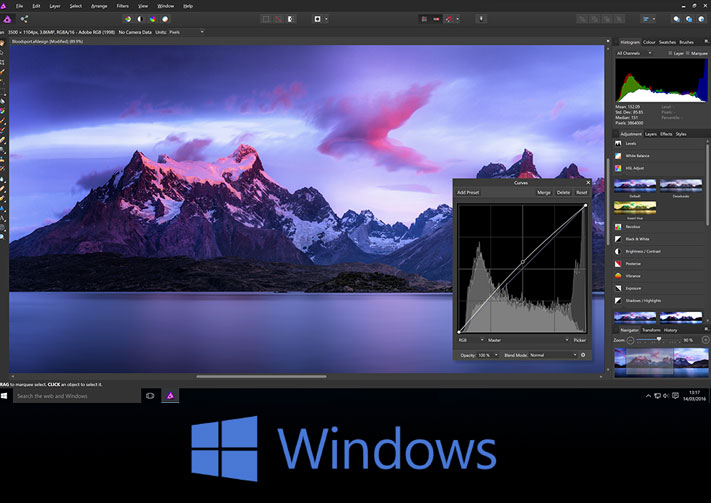
- #AFFINITY DESIGNER WINDOWS PDF#
- #AFFINITY DESIGNER WINDOWS FULL#
- #AFFINITY DESIGNER WINDOWS PROFESSIONAL#
Fully compatible with macOS Big Sur and optimized for Apple's M1 chips as well as 64-bit and multi-core processors Live pixel preview to see exactly how your design will export Slice export for exporting multiple elements in a single click
#AFFINITY DESIGNER WINDOWS FULL#
Full 16-bit per channel editing and end-to-end ICC color management
#AFFINITY DESIGNER WINDOWS PROFESSIONAL#
Professional CMYK, LAB, RGB, PANTONE©, and Greyscale color models
#AFFINITY DESIGNER WINDOWS PDF#
PDF passthrough and package your document alongside all used image and font resources into a single folder Select Same and Select Object functions for efficient attribute matching and object selection Access to royalty-free images through the Stock panel Customizable saveable presets, including studio presets for the UI layout Save documents as template files to re-use time and time again Advanced grids, snapping, and alignment Support for PSD, AI, PDF, EPS, SVG, JPG, TIFF, and EXR file formats Unlimited artboards and saveable history with alternate futures Flexible text handling with comprehensive support for OpenType, artistic text, and text frames High-quality raster tools for texturing, masking, and finishing artwork, including the ability to create custom brushes Switch between vector and raster workspaces with a single click Incredibly smooth gradient and transparency controls Live effects, blend modes, and image adjustments Pencil and brush stabilization for drawing super-smooth curves freehand Powerful contour tool to create abstract objects or increase the width of single open curves

Rock-solid vector tools including the best pen tool, node tool, curve editing, and smart shape tools available Incredibly accurate results with minimal nodes Seamless switching between tools and editing modes for frustration-free design Live pixel, retina, and wireframe view of vector artwork in and out of split-screen mode Optimized for documents of any complexity with zoom up to over 1,000,000% for absolute precision Live gradients, transforms, effects, and adjustments Choose View > Customise Tools to rearrange the icons across up to eight columns.- Real-time performance with smooth pan and zoom at 120fps
This tip is also useful in normal mode if you like to relocate the Tools panel to a secondary display (using View > Dock Tools). To merge only some windows, drag one’s title bar over another’s until the latter window turns blue, then let go. Too many document windows? Choose Window > Merge All Windows. Now drag one window’s left edge and the other’s right edge towards the centre of the desktop to divide the display between them. To split the desktop between documents but keep them as floating windows, hold opt and double-click any corner of one window, then repeat for the second. Split the view without entering full-screen mode If Window > Separated Mode is dimmed and so can’t be chosen, find the window that’s in full-screen mode, reveal the menu and title bars, then click the green button to exit full-screen mode. When you need those elements, move the pointer to the screen’s top edge to reveal them. This temporarily hides the menu bar and windows’ title bars. In macOS, you can press a window’s green button and choose Tile Window to Left/Right of Screen to arrange this and another window side by side in full-screen Split View mode. Separated Mode window management tips Where did the menu bar go? The larger, upper display might be devoted to documents and the lower one to panels and toolbars, with the toolbars placed at the adjoining edge for fast access.Īn example three-display arrangement, as defined in System Preferences’ Displays pane (bottom left), showing two different document views on separate displays, and toolbars and panels on a third display. For example, a MacBook with an external display standing over it, or an iMac with its desktop extended onto an iPad connected using Sidecar. One way to use this is with two displays arranged vertically. The Toolbar and context toolbar become one floating window, and each open document gets its own window too. Separated Mode dispenses with the main window.

In normal mode, the Tools panel and studio panels can be organised as you want, even across multiple displays, but the main application window always exists and contains the Toolbar, context toolbar and tabs for your open documents. Separated Mode is a feature of Affinity apps on macOS that splits the major interface components into discrete windows, enabling greater workspace customisation and making some tasks easier.įirst, let’s talk about Separated Mode’s key workspace differences.


 0 kommentar(er)
0 kommentar(er)
